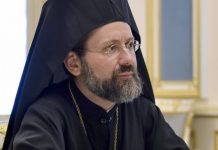For the first time since 1835, the monks of the Santo Domingo de Silos Monastery in Spain — known for their Gregorian chant — have been forced to abandon the seclusion of their cells. However, this time it’s not because of a political decision of the enemies of the Church but as a precaution against wildfires in the area.
At least eight buildings have been destroyed by the flames that are devastating the land surrounding the village of Santo Domingo de Silos, and more than 500 people have been evacuated from the area.
In a statement to ACI Prensa, CNA’s Spanish-language sister news agency, the monks said that the nuns at the Benedictine monastery of Santa María in the nearby town of Aranda de Duero are lodging them at their guest house.
The monks expressed their concern for the residents of the town, who have also been forced to leave their homes. They also lamented the damage caused by the fire in the village, the natural environment, and the agricultural and livestock businesses.
Confiscation of Church property
The monks haven’t had to leave their monastery since Juan Álvarez de Mendizábal, the powerful prime minister under Queen Isabel II, began the process of expropriating Church property from 1835–1837.
The confiscation included the expulsion of any religious order that was not directly dedicated to charitable works and, contrary to the argument used for its implementation, did not lead to a distribution of monastic lands but rather promoted the ownership of large tracts of farmland, usually by a single individual, especially in southern Spain.
Monastic presence for more than a millennium
The Monastery of San Sebastián de Silos, its original name, is first mentioned in a document from the year 954.
Due to the military campaigns of Almanzor (circa 939–1002), the de facto ruler of Muslim-occupied Spain, the monastery fell on hard times until the arrival of St. Domingo Manso in the 11th century, a monk who had been prior of the monastery of San Millán de la Cogolla in the town of La Rioja.
Under his direction, a Romanesque church was built as well as a cloister, elements of which still remain. After his death in 1073, the monastery was named after him. In 1170, the other St. Dominic — the founder of the Order of Preachers — was baptized there.
In the 18th century, the Romanesque church was replaced by a Baroque church, which still exists along with a new cloister.
The confiscation under Mendizábal meant, in addition to the expulsion of the monks, the loss of an important religious artistic patrimony and its historical archive.
In 1880, about 50 years after the confiscation, a group of Benedictine monks expelled from France were allowed to come to the monastery, restoring the life of prayer and work there.
Since then, this monastery has been the origin of several foundations in Spain, including Holy Cross abbey in the Valley of the Fallen, a monumental complex where both sides of the 1936–1939 Spanish Civil War are buried.
The monastery was damaged by a fire in 1970 but has been restored to its present condition.















